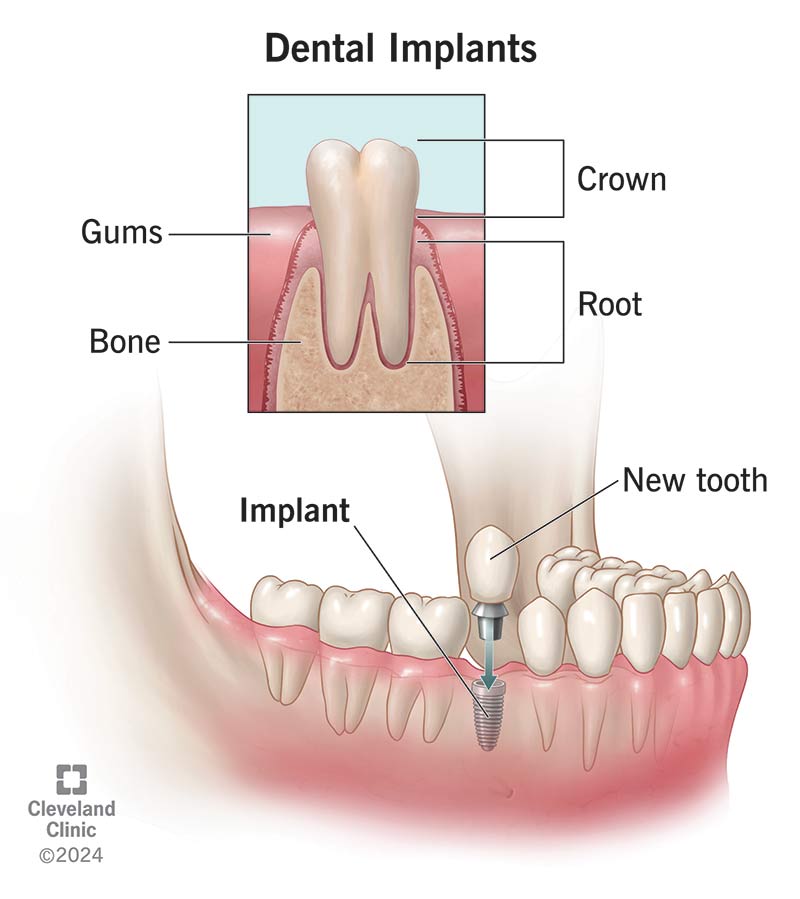Some Ideas on Dental Implants You Need To Know
Table of ContentsA Biased View of Dental ImplantsFacts About Dental Implants UncoveredWhat Does Dental Implants Mean?The Basic Principles Of Dental Implants
are clinical devices surgically dental implanted right into the jaw to restore a person's capability to eat or their appearance. They offer assistance for man-made (fake) teeth, such as crowns, bridges, or dentures. When a tooth is lost as a result of injury or disease, a person can experience problems such as quick bone loss, defective speech, or changes to chewing patterns that cause discomfort.
Structure of The Dental Implant System picking oral implants, speak with your oral provider concerning the potential advantages and risks, and whether you are a prospect for the procedure. Points to take into consideration: Your general health is a vital aspect in establishing whether you are a great prospect for oral implants, for how long it will take to heal, and the length of time the implant may remain in place.
Smoking cigarettes may influence the healing procedure and lower the lasting success of the dental implant. The recovery process for the dental implant body might take several months or longer, throughout which time you normally have a short-term joint in area of the tooth. the oral implant treatment: Thoroughly comply with the oral health guidelines offered to you by your dental service provider.
10 Simple Techniques For Dental Implants
Implant failing can cause the demand for one more procedure to deal with or change the dental implant system. Recovers the capacity to eat Recovers aesthetic appearance Aids maintain the jawbone from reducing as a result of bone loss Protects the wellness of the bordering bone and gum tissues Aids keep surrounding (neighboring) teeth steady Enhances high quality of life Damage to surrounding natural teeth during implant positioning Injury to the surrounding tissues throughout surgical treatment, such as sinus opening Injury during surgical procedure (for instance, crack of surrounding jawbone) Inadequate feature, such as feeling like the teeth do not attack with each other usually A feeling that the tooth is loosened or turning in location resulting from a joint screw loosening up Implant body failing (looseness of the implant body) due to systemic infection, which might be more probable in individuals with unrestrained diabetes as a result of local infection in bone and periodontals sustaining the dental implant body due to postponed recovery, which might be a lot more likely in patients that smoke Trouble cleaning up the gums around the dental implant, leading to inadequate dental hygiene Neglected gum illness Post-surgical tingling because of nerve impingement or damage Constantly notify healthcare carriers and imaging service technicians that you have dental implants before any magnetic vibration imaging (MRI) or x-ray procedures.
FDA is not conscious of any unfavorable events reported for MRI or x-ray treatments with oral implants. Dental implants systems are commonly made of products that follow worldwide agreement standards of the International Company for Standardization (ISO) or ASTM International. These standards have details of what makes a secure product.
Other products such as gold alloys, cobalt-based alloys, titanium alloys, or ceramic products are occasionally utilized. The safety and security accounts of these materials are well-known. Dental dental implant systems are examined according to global agreement standards. Biocompatibility screening, to show that bodily contact with the gadget does not create complications like inflammation or allergy, becomes part of the examination that helps ensure the materials in the dental implant system are safe and do not cause unfavorable impacts when implanted in people.

Dental Implants for Dummies
Some individuals are not qualified for oral implant surgery. It is for dental specialists to run on individuals with: severe illnessuncontrollable metabolic diseasebone or soft cells illness or infectionIf these concerns are resolved, a person can have the surgery. Dental Implants. In, dental cosmetic surgeons avoid operating people with: If people with any of the above go through dental implant surgery, there is a higher risk of the dental implant failing
Some people have a jawbone irregularity that my blog prevents adequate bone for a dental implant from creating. The specialist will after that utilize a bone or bone substitute to repair and construct up the area.
Dental dental implant surgical treatment is a tailored process. It's not the same for every person. The complying with gives a general introduction of what you can expect your dental expert, oral doctor, periodontist or prosthodontist to do: Put the implant surgically. Offer you time to heal. Attach the blog post and final crown, bridge or denture.
Next, your cosmetic surgeon will carefully put the oral implant right into your jaw. If your dental implant is near the front of your mouth, your dentist will certainly make a short-term tooth for you to put on until you heal.
Some Known Questions About Dental Implants.
Your company can tell you what to expect in your circumstance. Throughout the recovery stage, your jawbone must fuse to the dental implant. This process, called osseointegration, is critical for stability and pop over to these guys lasting success. This procedure can take anywhere from three to nine months. Sometimes, it might take much longer.
When your dental implant heals, your dental practitioner can connect the abutment (small adapter blog post) and your last remediation (crown, bridge or denture). This typically takes about one hour to complete and may require a 2nd minor surgical procedure. You shouldn't feel any kind of pain during your oral implant treatment since your company will certainly make use of medicine to numb your gums.